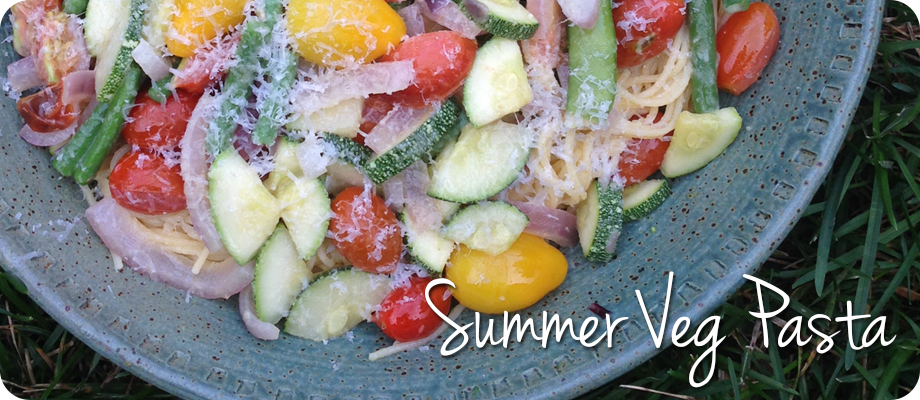
by Kristen | Aug 15, 2014 | garden food, LB Tutorial: Recipes
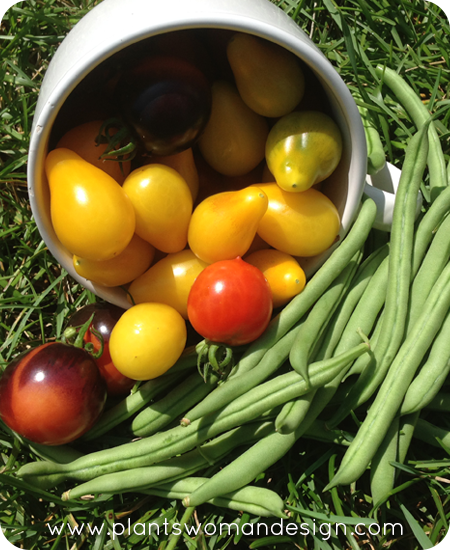 I went to the garden to check on the pumpkins on Monday and grabbed a large soup mug on my way out as an after thought. After all, you should never go into the garden without something to collect your fruit and veg in. This particular trip found my container woefully inadequate. Our tomatoes are looking amazing and between the three families that tend the garden we seem to be keeping up with what the tomatoes can produce. The beans are coming in nicely as well. We thought a beetle had damaged them but they seem to be coming along just fine.
I went to the garden to check on the pumpkins on Monday and grabbed a large soup mug on my way out as an after thought. After all, you should never go into the garden without something to collect your fruit and veg in. This particular trip found my container woefully inadequate. Our tomatoes are looking amazing and between the three families that tend the garden we seem to be keeping up with what the tomatoes can produce. The beans are coming in nicely as well. We thought a beetle had damaged them but they seem to be coming along just fine.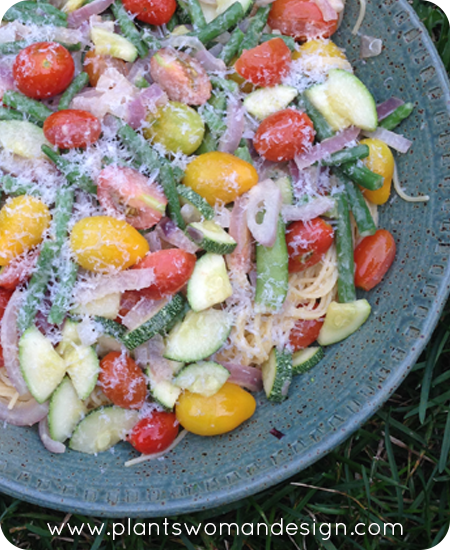 One of our favorite recipes to make with veggies is a Pasta Primavera Pronto recipe adapted from Epicurious.com. The original recipe calls for frozen veg, which is great for winter evenings when you’ve been cooped up in the house too long and cabin fever is starting to set in. But in the summer when fresh veg is available it would be a travesty not to use it in this amazing dish. Here is our recipe for Fresh Pasta Primavera.
One of our favorite recipes to make with veggies is a Pasta Primavera Pronto recipe adapted from Epicurious.com. The original recipe calls for frozen veg, which is great for winter evenings when you’ve been cooped up in the house too long and cabin fever is starting to set in. But in the summer when fresh veg is available it would be a travesty not to use it in this amazing dish. Here is our recipe for Fresh Pasta Primavera.
Fresh Pasta Primavera
- 3/4 lb fresh green beans, snapped and cut in half
- 1/4 lb fresh peas
- 1 small to medium zucchini cut into bite size pieces
- 1 red onion, cut into quarters through the root end then sliced thin
- 3 dozen small tomatoes (we used cherry, grape, yellow pear and quartered indigo rose)
- 8 garlic cloves, finely chopped
- 1 lb dried spaghetti (we used Barilla Gluten-free spaghetti)
- 1/4 cup olive oil
- 1/4 teaspoon dried hot red pepper flakes
- 3 tablespoon unsalted butter
- 1/4 cup finely grated Parmigiano-Reggiano cheese
Bring a large stock pot of water to a boil. Add green beans and peas and parboil for 2 minutes. Remove veggies from the boiling water with a slotted spoon or small strainer and set aside. Do not pour out the boiling water!
While the veggies are parboiling, heat the olive oil in a large skillet over medium-high heat. When the oil is hot add garlic and red pepper flakes. Cook for 45 seconds, taking care not to burn the garlic, to make a spicy garlic oil. Pour the oil and all the garlic and pepper bits into a small container and set aside.
Return the veggie infused water to a boil, add the dried pasta, cook until al dente. When the pasta is finished, strain in a colander and place in a serving dish. Toss the pasta with the spicy garlic oil you made earlier (garlic bits and all).
While the pasta is cooking saute the red onions in the skillet with a touch more olive oil until they begin to soften. Add the zucchini. When the zucchini is heated through add the tomatoes. When the tomatoes have begun to warm, make a space in the middle of the pan and toss in the butter and grated cheese.
When the tomatoes have been well heated and the butter melted, layer the contents of the skillet over the pasta. Grate additional cheese over the dish to taste and serve immediately.
NOTES: You can use any combination of veggies that you want to use. We used beans, zucchini and tomatoes because that’s what we had on hand (we almost always use broccoli but were fresh out this round). The one veggie I would never omit if I didn’t have to is the tomatoes. They add a fresh burst of flavor you just can’t replace. I know some folks have a hard time with onion and garlic. You can modify these items to your taste but don’t skimp on the garlic if you can help it. We tend to keep the onions bigger so our little ones can pick them out. If you like yours smaller by all means dice those babies! We have not tried any other oils than olive oil for this recipe. If you try coconut oil or any other kind let us know how it turns out.
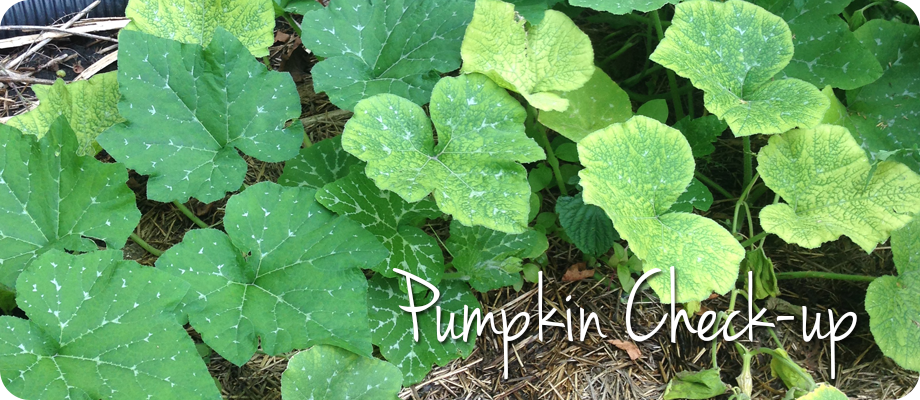
by Kristen | Aug 13, 2014 | Community Gardens, LB Tutorial: Growing Food
At the beginning of August we talked about hand pollinating pumpkins (you can read about it HERE). You might remember I had one little problem when I went out to make baby pumpkins. I only had male flowers and didn’t see any female flowers. After a few days of checking in with the pumpkins I still don’t see any female flowers. But when I went to the garden today I saw something a little different…
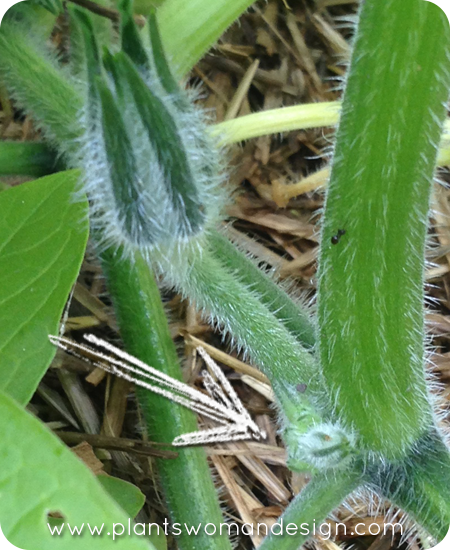 You can see the bigger flower, which is likely to be a male flower again, but lower on the stem is another bud. This one looks different and I haven’t seem them like this before. It’s so much smaller, closer to the stem but coming out of the same joint. It’s also a little plumper than what the male flowers look like this small. I could be wrong but I’m really, really hoping this is a female flower. REALLY hoping…
You can see the bigger flower, which is likely to be a male flower again, but lower on the stem is another bud. This one looks different and I haven’t seem them like this before. It’s so much smaller, closer to the stem but coming out of the same joint. It’s also a little plumper than what the male flowers look like this small. I could be wrong but I’m really, really hoping this is a female flower. REALLY hoping…
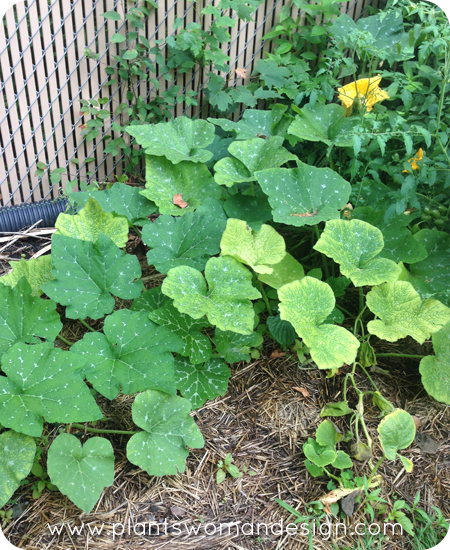 Other things I noticed about the pumpkin vines. After the pumpkin vines began to grow they started running behind the tomatoes. I asked the Plantswoman and she said they were probably getting too much sun so they found a shadier spot. Once the trees fully leafed out above the pumpkins providing more shade the vines started to find their way back to their intended spot. I’m actually glad they retreated behind the tomatoes because their vines are ginormous! It will be difficult to find the rest of the flowers and spy out the fruit since the tomatoes are heavy with fruit but we will make it work.
Other things I noticed about the pumpkin vines. After the pumpkin vines began to grow they started running behind the tomatoes. I asked the Plantswoman and she said they were probably getting too much sun so they found a shadier spot. Once the trees fully leafed out above the pumpkins providing more shade the vines started to find their way back to their intended spot. I’m actually glad they retreated behind the tomatoes because their vines are ginormous! It will be difficult to find the rest of the flowers and spy out the fruit since the tomatoes are heavy with fruit but we will make it work.
So, I’m keeping my fingers crossed these pumpkin vines will produce an actual pumpkin. I’ll keep you posted!
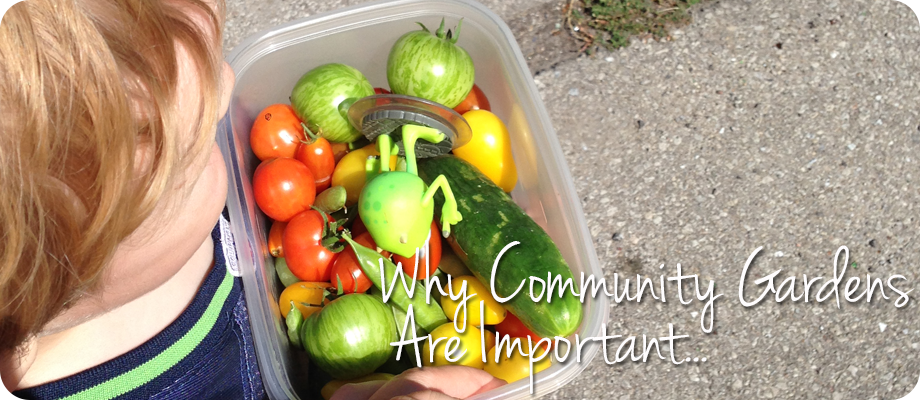
by Kristen | Aug 6, 2014 | Community Gardens
Over the last few months we’ve been following along with and visiting community garden’s in our area and afield. You might be wondering why we are devoting so much time to this topic so I wanted to share more about it. It’s been pretty eye opening for me as I begin to understand more and more how a community garden can be an invaluable resource to a community. This past weekend my little family and I headed over to Detroit, Michigan to visit with some friend and one of our hosts shared a funny story about the ‘hippie’ in the community garden and the current rant he’s on. While we found the story amusing I think it illustrates a pretty widely held perspective that the folks that work in the community garden are old hippies with wild rants about the government. This is changing.
Food is powerful.
When Susan visited the Railroad Community Garden in Oregon she found a modern family using their allotment to provide fresh veg for their family. “They were a low income family who had used one of the scholarships to get a plot.” This is why community gardens are so important. For many low income families access to a community garden is the most reliable way they can provide fresh, healthy produce for their families. You don’t need to have a yard, you don’t need to go it alone, you don’t even need to have an address to have access to quality produce. Of course you need to put in the work but for folks with more time than money this is not an issue.
The ability to grow your own food is empowering.
Every day families are forced to make decisions based on money not nutrition. When one meal’s worth of fruit and veg costs the same as two or three prepackaged full meals most folks would logically choose to stretch their dollar into the three meals. And what kind of a choice is that? Is it top-noch nutrition? No. Will it fill a hungry belly? Yes. And so the cycle goes. Give a family access to a garden plot and that family has the opportunity to turn the tables on that equation. It may be just for the growing season but still better than none at all.
This issue affects each community differently and so I encourage you to look up and see if your community has/needs these resources and get involved! We may have officially become the new ‘hippies’ with a rant to share.
Click below to see the latest community garden posts!
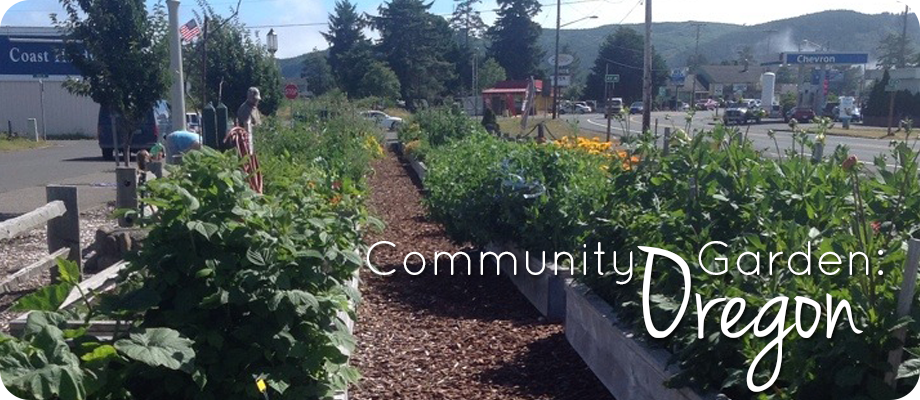
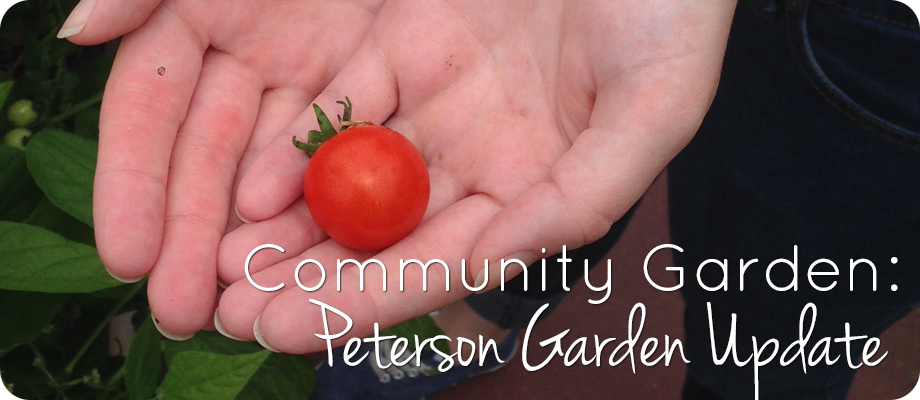
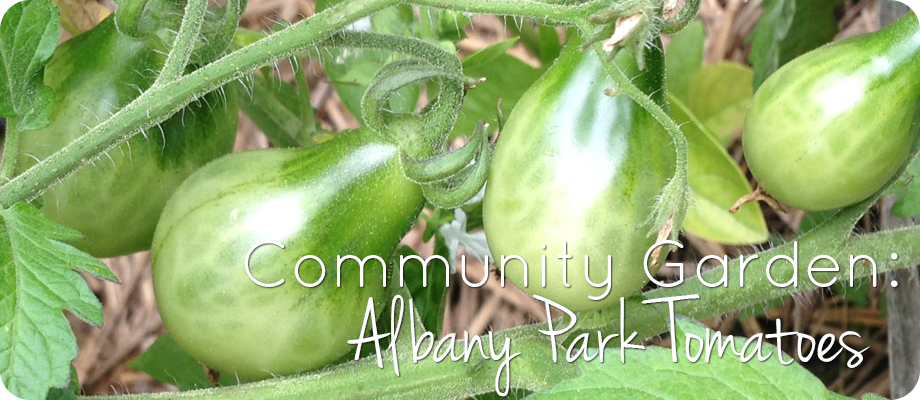
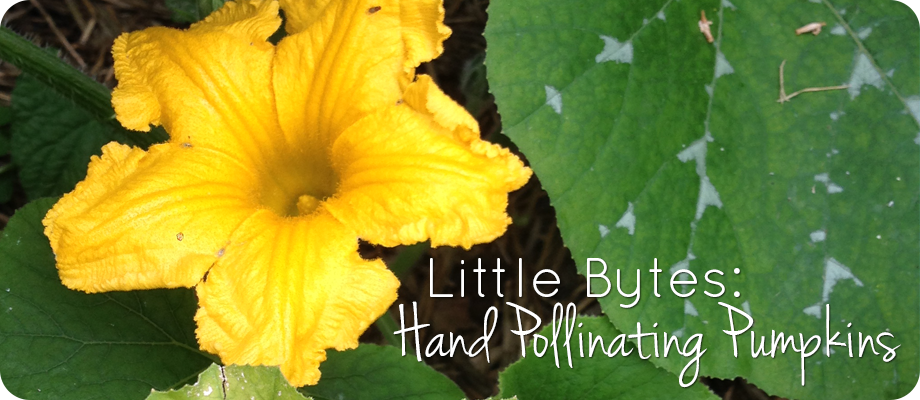
by Kristen | Aug 1, 2014 | LB Tutorial: Growing Food, Little Bytes
You may remember that the kids and I planted pumpkins this past spring and I’m happy to report we’ve had some success. Here are three of our pumpkins growing over at the Albany Park community garden. They are pretty happy and seem to be making their way behind the raised bed of the tomatoes. In hindsight I think I would have trellised them to make use of the vertical space we have. Definitely making a note about that for next year.
 At this moment we have one blooming flower and two spent flowers. After talking with the Plantwoman she mentioned I should probably hand pollinate the pumpkins.
At this moment we have one blooming flower and two spent flowers. After talking with the Plantwoman she mentioned I should probably hand pollinate the pumpkins.
(insert crickets)
“How do I do that?” I say. “With a paintbrush” she says. “Yeah, but how?” I say “Do you have a video or something showing how to do it?”
A few minutes later I have THIS video on my phone and all makes a lot more sense. I watched it a few times specifically watching for what the difference is between male and female flowers which, although not specifically mentioned in the video, is clear to see. So, off to the garden with myself to see about my pumpkins.
 I check our one blossom and it seems to be a male flower. So, I check the other spent blooms, they too seem to be male flowers.
I check our one blossom and it seems to be a male flower. So, I check the other spent blooms, they too seem to be male flowers.
 So, no hand pollinating for me today. We have quite a few more blossoms coming up so we aren’t done yet. Unfortunately, according to my research, the way the blossoms are stretching up from the stem means they are also likely male flowers. Female flowers would be closer to the vine with a pre-fruit or ovary just behind the flower just waiting to be fertilized. I guess this happened to my Aunt last year and there isn’t really anything one can do about it except wait.
So, no hand pollinating for me today. We have quite a few more blossoms coming up so we aren’t done yet. Unfortunately, according to my research, the way the blossoms are stretching up from the stem means they are also likely male flowers. Female flowers would be closer to the vine with a pre-fruit or ovary just behind the flower just waiting to be fertilized. I guess this happened to my Aunt last year and there isn’t really anything one can do about it except wait.
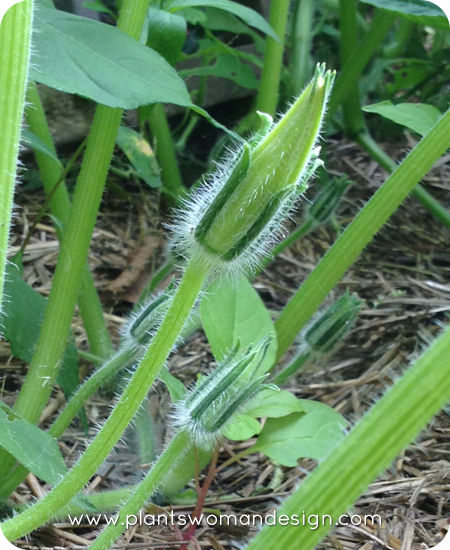
Why is this important? Bees. Or the lack of them in most cases. Since pumpkins grow separate male and female flowers they rely on bees and other insects to pollinate the female flowers. Without pollination you won’t see any fruit so you may have to take matters into your own hands, literally. Male flowers are first to appear to help attract the pollinators with the female flowers following. Because of that I’m not going to worry too much about only having male flowers right now. When the time comes, however, I will know what I need to do.

by Kristen | Jul 30, 2014 | Community Gardens
Well, it’s finally happened, we are starting to harvest veg from our community garden plots. I visited the Peterson Community Garden with my friend Megan this past Friday and the amount of produce that is now available through out the garden is impressive. Megan said some of the plants seem to be doing fine and some don’t seem to be doing that great but they are keeping an eye on things.
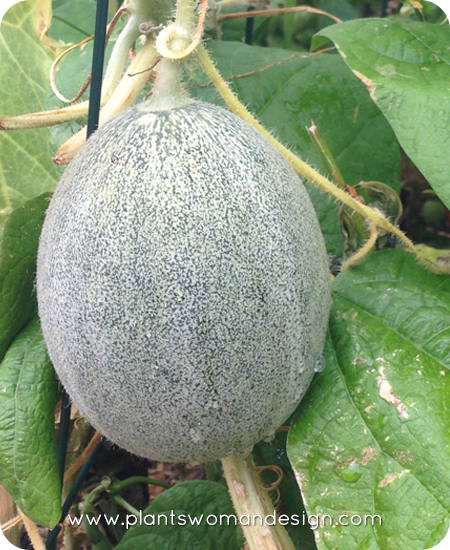 This little beauty is a major win in my mind. It’s a cantaloupe! Being born and raised in the NW I’ve never seen a cantaloupe on the vine nor have I ever dreamed a home gardener could grow them on their own. Such funny perspectives we can adopt sometimes… But here we stand looking at a lovely vine with about 10 or so little melons getting ready to go.
This little beauty is a major win in my mind. It’s a cantaloupe! Being born and raised in the NW I’ve never seen a cantaloupe on the vine nor have I ever dreamed a home gardener could grow them on their own. Such funny perspectives we can adopt sometimes… But here we stand looking at a lovely vine with about 10 or so little melons getting ready to go.
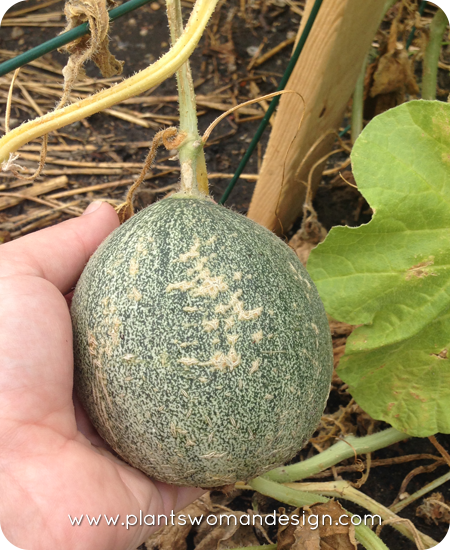 This little guy is already starting to get the cantaloupe “fuzz” although it be still pretty small.
This little guy is already starting to get the cantaloupe “fuzz” although it be still pretty small.
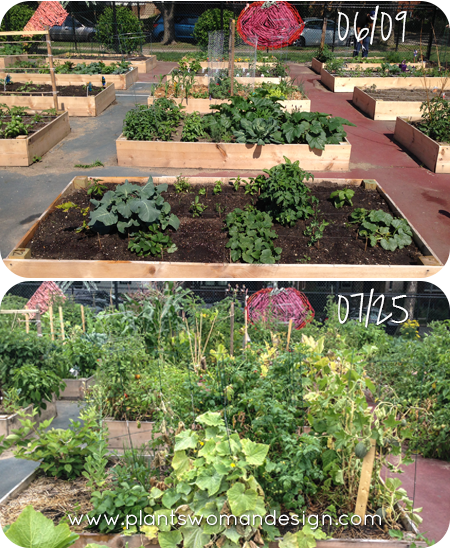 When I first wrote about the Peterson garden everything was so neat and organized with clearly defined raised beds. Fast forward just about a month and a half and you have a veritable garden jungle! It’s just amazing to me!
When I first wrote about the Peterson garden everything was so neat and organized with clearly defined raised beds. Fast forward just about a month and a half and you have a veritable garden jungle! It’s just amazing to me!
As Megan and I watered their plot we talked about their tomatoes and I wondered what they will do with the bounty (there are lots of little green guys just waiting to ripen up). She said they were going to take a class about preserving the produce and then they were hoping to save the extras using what they learn at the class. I wondered about supplies and she said they only needed to bring the jars and produce and the class would provide the rest. This is so encouraging to me as I can get overwhelmed by the preceived monetary outlay of a canning project. When we moved we (perhaps foolishly) sold all of our canning supplies. I’m kind of dying a little over it now thinking about how much use we could get out of it now. Knowing you can “complete the cycle” by preserving your produce via canning with the community garden makes me feel better about it. It’s a great reason to come out of my own little bubble and be involved in what’s happening in my own neighborhood.
Come back later this week for a look at our tomatoes over at Albany Park…

by Kristen | Jul 28, 2014 | Community Gardens, garden food
Spring and summer have been off to slow start where we are but that is not deterring our tomatoes! We’ve got lots of tomatoes coming in and ripening quickly. Beside the few pictured here we also have Brandy Wine and Amish Mom tomatoes coming right along.
Here are our grape tomatoes. There are so many more in the upper vines just waiting for a few more sunny days.
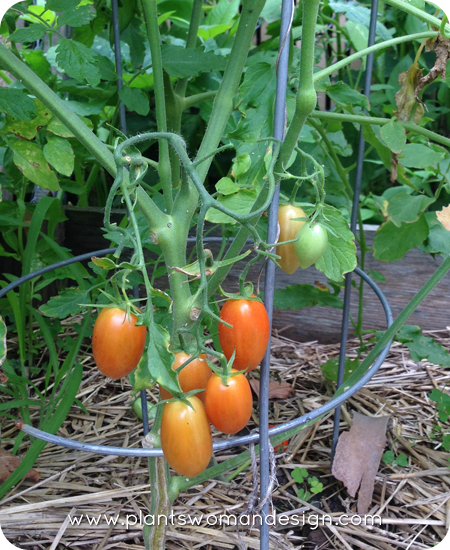 Idigo Rose tomatoes… This one still kind of freaks me out a little. Tomatoes are in the Nightshade family and the poisonous version sports little tomato like fruits that start green, go red and then black. I’m sure these will be delicious once I get over the life threatening part.
Idigo Rose tomatoes… This one still kind of freaks me out a little. Tomatoes are in the Nightshade family and the poisonous version sports little tomato like fruits that start green, go red and then black. I’m sure these will be delicious once I get over the life threatening part.
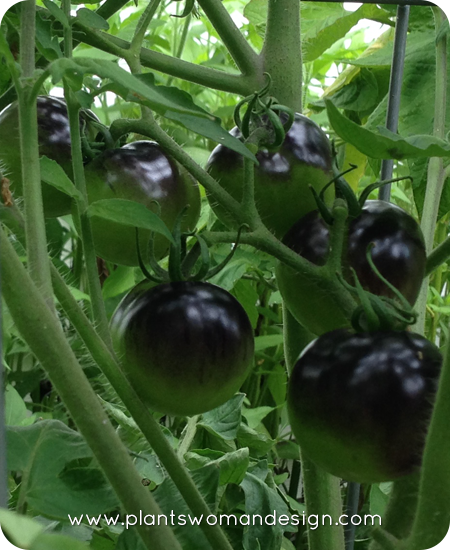 Yellow pear tomatoes still growing. When they are ripe they will be a lovely yellow color. There have been a few that we’ve tasted already but the flesh is a bit mealy. No complaints here though and the kids don’t seem to care.
Yellow pear tomatoes still growing. When they are ripe they will be a lovely yellow color. There have been a few that we’ve tasted already but the flesh is a bit mealy. No complaints here though and the kids don’t seem to care.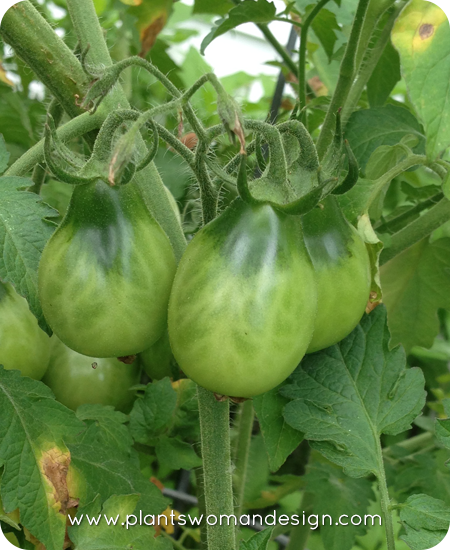 And last but certainly not least, green zebra tomatoes. Subconsciously I’ve been waiting for these guys to get red and then I read their name again. They are supposed to be green! I pulled gently on some that looked ‘done’ and they fell into my hand so we can put them into the rotation of harvest.
And last but certainly not least, green zebra tomatoes. Subconsciously I’ve been waiting for these guys to get red and then I read their name again. They are supposed to be green! I pulled gently on some that looked ‘done’ and they fell into my hand so we can put them into the rotation of harvest.
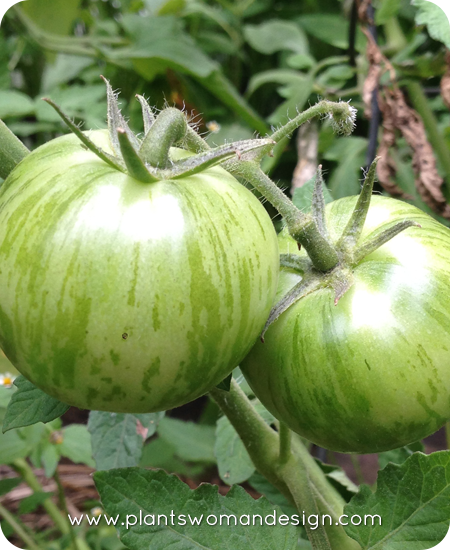
That’s what is going on in our garden right now. What are you harvesting in your garden?
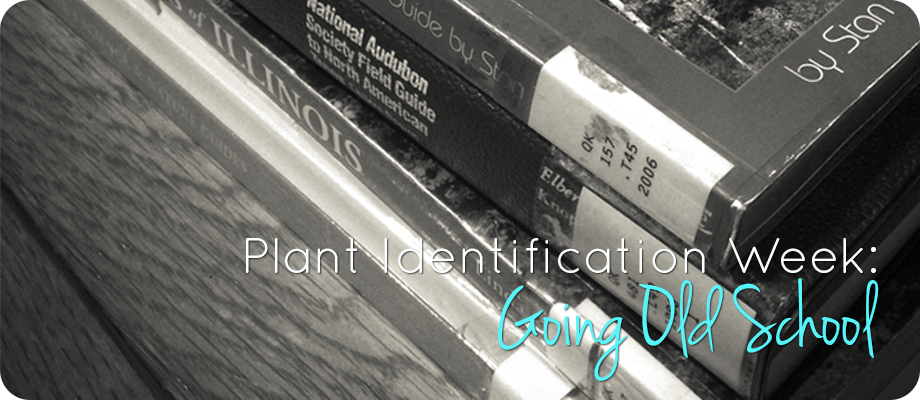
by Kristen | Jul 4, 2014 | plants
Welcome back and happy Independence Day! This week we’ve been talking about how to identify the trees and plants around your home/property/neighborhood. On Wednesday we talked about some free mobile apps, if you missed that post you can read it HERE, and today we are talking about books. Yep, good old fashioned ink-on-paper-feel-the-binding-turn-the-pages books. After being slightly disappointed with the apps I tested out, except for Garden Compass, I started to wonder if I was going about this all wrong. Just because there is an app available doesn’t seem to mean it’s the best tool for the job. With that in mind I headed to my local library to see what I could find.

I’ll admit the last couple times I’ve walked into a public library I’ve been a little stumped as to where to start. This time I went straight to the reference desk and asked for help. The lovely lady there asked me what I was looking for. I told her I was looking for books to help me identify the trees in our neighborhood. She then asked me if I was working with kids or not and I said yes to both, just to see what she would come up with, and away we went. She took me to several different places around the library and left me in the garden section to make my selections. As you can see from the photo I’m in Illinois so I picked up books specific to this state. Your local library will likely have resources specific to your area. I didn’t really have a rhyme or reason for picking the books I came home with. I just took a quick flip through the book to see if it seemed helpful then decided. The Audubon book is the only book I immediately picked up with out looking through it based on the Audubon’s reputation.
After leaving the library I headed to a coffee shop near by to take a look at what I’d found. Using the photos I had submitted to Garden Compass I tried to identify the plants I had found.
Here’s what I ended up with…
National Audubon Society Field Guide to North American Trees: Eastern Region I started with this guide once I had a lovely iced beverage in my hand. After leafing through it a bit I went back to the beginning “how to use this guide” section and continued on from there. I was able to identify the Linden tree (or American Basswood) fairly quickly but got stuck when it felt like the variety I had in my neighborhood was more akin to the Carolina Basswood, which is not found in my area, than the American Basswood, which is found in my area. To cross reference I moved onto the guides specific to my area.
Trees of Illinois by Stan Tekiela To help me identify the Linden tree more accurately I started with this guide. Again, I took a look at the “how-to” section and then dove in. One of the features I enjoyed in this guide was the use of icons on the corners of the pages to help you identify your specimen more efficiently. I also took a look at Trees of Illinois by Kinda Kershaw. Both guides had great information and each included their own sometimes anecdotal information which made for an interesting read.
Had I been familiar with the way guide books were set up I may have had slightly better luck with the apps I tried as they have some of the same structural pieces woven into them.
Science & Nature Guides Trees was a book the librarian pulled for me for working with kids. The book itself covers trees from the United States and Canada. What I found great about it were the activities that were included. Such as how to measure the height of a tree, how to figure out the age of a tree (with out cutting it down to count the rings of course) and tips on collecting leaves. I will be pulling some activities from this book to do with my kids. I’ll post our results and printables tomorrow here on the blog.
After all is said and done there is something to be said about reaching for a book instead of a computer to find the information you need. Feeling the heft of the book in your hand, catching the slight scent of the pages as you turn them, slowly mulling over the words on each page… It’s slow and unhurried. I am grateful for the speed at which I can get the information I need with out much fuss. I love being able to follow my friends and family on Facebook and see what they are up to on Instagram but lately I see that there is an increasing need in myself to stop and look up. To slow down and not expect instant access to the entire world at a moments notice. To engage in my community. To be present with my family. Maybe it’s just a mental thing but picking up a book instead of a computer, not matter how small, feels like permission to slow down and I’ll take it.
Sifting through the field guides was an enjoyable venture and I’m now eager to share what I’ve found with my kids. Did I find an old school answer to an old school problem? Yes, I think I did. And while it’s great to have an app like Garden Compass in my back pocket for when I get truly stumped I’m so pleased to know how to navigate through a field guide and will be adding some of these books to our home library soon.
Check back tomorrow to see our books in action!
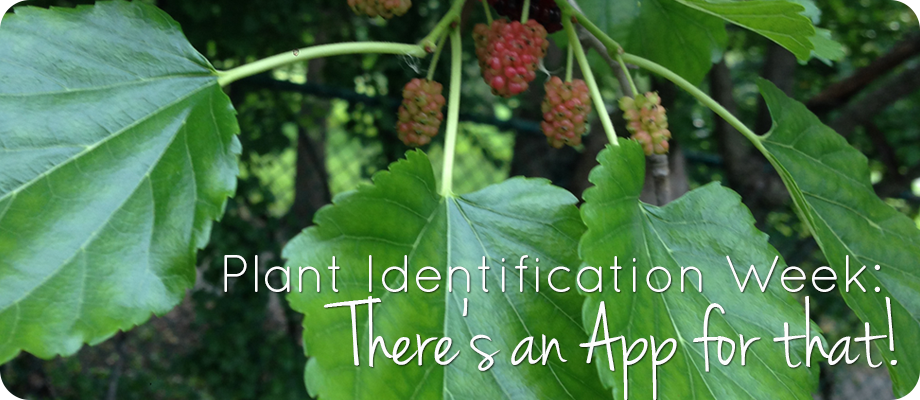
by Kristen | Jul 2, 2014 | plants
With Plantswoman’s office move I got to thinking about new homes and what to do about the gardens you inherit. Depending on what time of year you move it can be difficult to identify what is in your new garden or on your new property. So, I set out to see what I could find in terms of plant ID help. Our posts this week will be focused on plant ID resources starting today with free apps.
To start our discussion on apps let me just say there are tons of reviews out there for all sorts of plant ID apps (google tree ID apps or plant ID apps to review). So, instead of recreating the wheel I will simply let you know how they worked for me. The free apps I tried this round were Leafsnap, TreeID and Garden Compass. I chose these apps based on their reviews and general set up. Occasionally I suffer from technology ADD and using apps is when it comes out with a vengeance. I don’t like to spend a lot of time setting up apps and I want them to be pretty straight forward to use. I don’t typically read a lot of “how-to” articles before just diving in. When I started this project my intention was to download an app, grab my notebook and my little girl and head out to play tree detectives in our neighborhood. In spite of my enthusiasm I chose to download the apps and play with them first before dragging my daughter out into the neighborhood and I’m so very glad I did and I’ll tell you why as we go along.

First up is Leafsnap. Leafsnap is a pretty cool app that uses facial recognition software to identify plants. To ID a plant in question simply take a photo of it and let it search the database to find your answer. For the software to work however you do need to photograph your specimen on a white background. This is easily accomplished by using a notebook (which is what I did) or a piece of printer paper with out having to take the specimen off the plant. Some of the reviews I read complained of having to pick a leaf off the plant/tree which is destructive but with a little creative thinking I can’t really think of a reason you’d need to do that. So, what was my result? As cool as it is that Leafsnap has modified facial recognition software to ID plants it failed to ID every plant I tried. You may be wondering why (I certainly was)… It’s because Leafsnap is linked to the Smithsonian Institution’s catalog of trees and plants and that collection only covers the Northeastern United States. If you live in the northeastern United States you may have better luck with it than I but in the meantime we will need to wait as they work on expanding their catalog. They do have a pretty neat set of plant ID games but they tended to be a little buggy so I’d recommend waiting until they fix that as well.
 Next up is a free app called Tree ID and instead of using a recognition software it uses a database which is downloaded onto your phone/device. Once you open the app you answer some questions about your tree or plant and the app searches the database to find your answer. So I gave it a try. I diligently selected the leaf, leaf type, leaf arrangement, leaf size, leaflet size, number of leaflets (I didn’t really know what these were so I guessed to see what would happen), leaflet characteristics, leaf edge, leaf lobes (again, not quite sure), leaf edge teeth, leaf veins, leaf underside, leaf base, leaf stalk, leaf shape, leaf tip… And then you answer questions about the bark, autumn color, fruit and flowers. It took a long time to go through all that. I never knew there was so much that could be asked about leaves! And if that wasn’t enough I didn’t really know what half of the terms meant. There are little question mark symbols on each question that tell you what everything is but quite frankly I was a little overwhelmed by the detail. I tried to ID the lilac tree in our back yard by answering as many of the questions that I could and came up with no result. Then I tried again and reduced the number of questions I answered to give it a broader spectrum to choose from and still no result. By then I was just frustrated that technology had let me down that I went inside and did a little more research. There had to be something that was actually useful to a novice like me.
Next up is a free app called Tree ID and instead of using a recognition software it uses a database which is downloaded onto your phone/device. Once you open the app you answer some questions about your tree or plant and the app searches the database to find your answer. So I gave it a try. I diligently selected the leaf, leaf type, leaf arrangement, leaf size, leaflet size, number of leaflets (I didn’t really know what these were so I guessed to see what would happen), leaflet characteristics, leaf edge, leaf lobes (again, not quite sure), leaf edge teeth, leaf veins, leaf underside, leaf base, leaf stalk, leaf shape, leaf tip… And then you answer questions about the bark, autumn color, fruit and flowers. It took a long time to go through all that. I never knew there was so much that could be asked about leaves! And if that wasn’t enough I didn’t really know what half of the terms meant. There are little question mark symbols on each question that tell you what everything is but quite frankly I was a little overwhelmed by the detail. I tried to ID the lilac tree in our back yard by answering as many of the questions that I could and came up with no result. Then I tried again and reduced the number of questions I answered to give it a broader spectrum to choose from and still no result. By then I was just frustrated that technology had let me down that I went inside and did a little more research. There had to be something that was actually useful to a novice like me.
You may be picking up on the fact that this isn’t the most scientific research ever performed but this is how I roll. I’m sure I’m not the only one who is short on time. Like I said in the beginning I am looking for something easy to use, straight forward and helpful. I’m pleased to let you know I think I found something pretty special. Garden Compass…
When I was over at Gardenista looking at their review of ID apps (they had similar disappointing results by the way) I remember someone mentioning Garden Compass in the comments. I figure it couldn’t hurt so I took a look. Garden Compass is different from Leafsnap and Tree ID because it doesn’t rely on a database to ID your plant rather it relies on people. Yep, you read right, an actual person responds to you. Here’s how it works. Download the app to your phone or device and then you can take a photo or use a photo from your device that you’ve already taken. The app then emails the photo and the question to the Garden Compass Team. Once they’ve received your email you get a confirmation email and an idea of how long it should take them to get back to you. My emails both said “Our experts are doing their best to keep our response times to less than 24 hrs” and they aren’t kidding. I sent my question in at 3:51pm and had an answer back by 6:19am the next morning! Here is what I sent in…

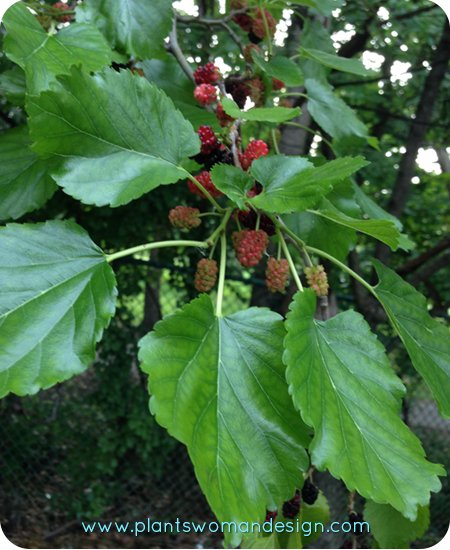 Here is what I got back…
Here is what I got back…
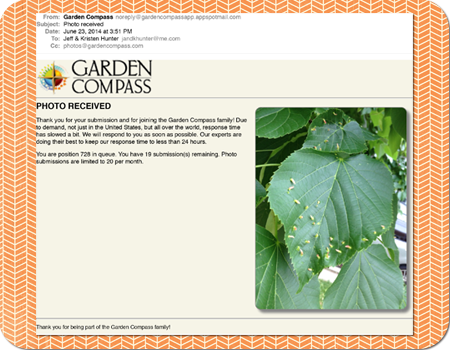
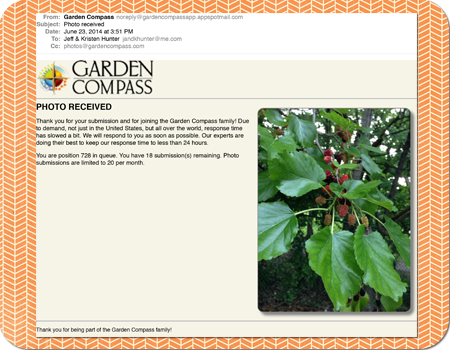 Did you notice how many were in queue before me? 728! The confirmation emails also keep tally of how many submissions I have left. You get 20 submissions per month.
Did you notice how many were in queue before me? 728! The confirmation emails also keep tally of how many submissions I have left. You get 20 submissions per month.
Pretty much the next day this was the response…
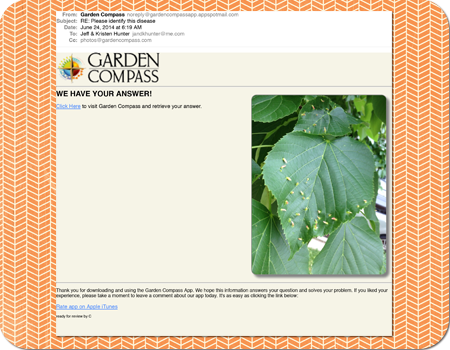 Click HERE to see all the answers they’ve sent me. I’ve sent in three submissions so far and all were correct with one slight exception. The identification of the tree with the leaf galls was given with a caveat that they couldn’t see enough of the tree to be sure so they made a guess.
Click HERE to see all the answers they’ve sent me. I’ve sent in three submissions so far and all were correct with one slight exception. The identification of the tree with the leaf galls was given with a caveat that they couldn’t see enough of the tree to be sure so they made a guess.
So, of the apps I tried, mind you I stayed with the free apps this round, Garden Compass is by far my favorite. They were quick and efficient and I really liked that I didn’t have to figure out how to finesse a database to give me what I wanted. And while there seems to be an app for just about everything my experience begs the question, is an app the appropriate way to go about this? Just because there are plant and tree ID apps out there perhaps the best way to go about this is the “old school” method. Come back on Friday as I head to my local library in search of an old school answer to an old school problem.
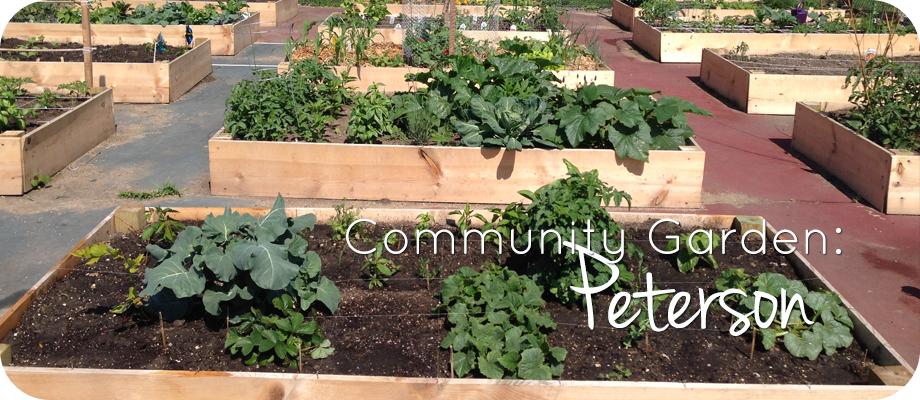
by Kristen | Jun 20, 2014 | Community Gardens
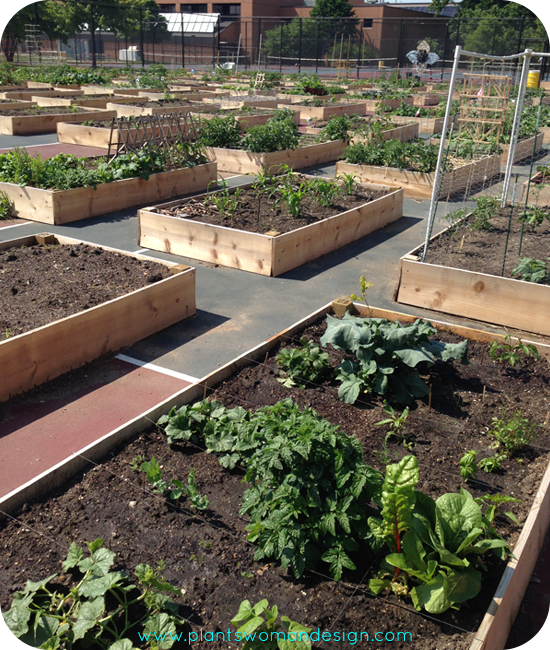
Today we get to take a tour through the Peterson community garden and I’d like to introduce you to Megan, Zach, Karrie and Caleb (if I can get them all there at the same time I’ll post a picture). They heard about the Peterson garden around the same time and decided to work together on a plot. All four would consider themselves novice gardeners and have been learning a lot through the community garden program. As Megan and I walked through the garden you could tell there were gardeners of all skill levels, even some that hadn’t started planting yet. There are plots that are bursting their seems already and some that have their first little seedlings coming up.
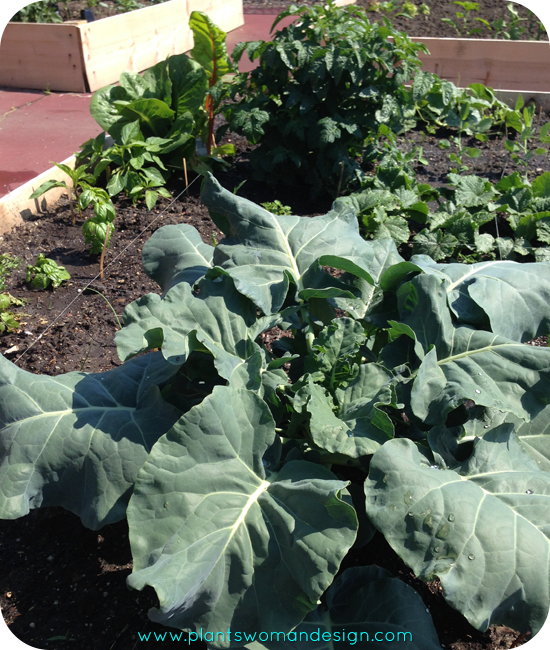 Currently “Fab Four” are growing Blueberries, blackberries, strawberries, peas, tomatoes, carrots, chives, basil, jalapeno peppers, banana peppers, red pepper and cantaloupe! When Megan ran me through the list of edibles in their garden I was impressed and excited for them. I’m especially excited to see how the cantaloupe turns out. That also happens to be a favorite of the Four as well. It really goes to show how much can be grown in a relatively small space.
Currently “Fab Four” are growing Blueberries, blackberries, strawberries, peas, tomatoes, carrots, chives, basil, jalapeno peppers, banana peppers, red pepper and cantaloupe! When Megan ran me through the list of edibles in their garden I was impressed and excited for them. I’m especially excited to see how the cantaloupe turns out. That also happens to be a favorite of the Four as well. It really goes to show how much can be grown in a relatively small space.
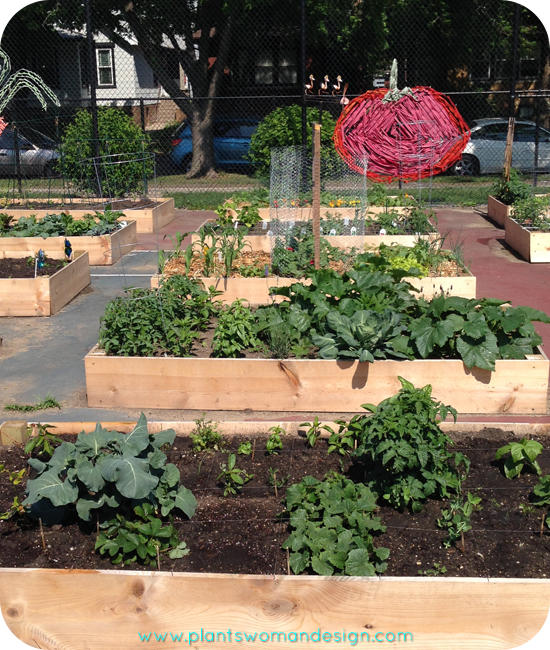 I’ve really enjoyed getting to see a new community garden come alive. We will keep checking in on the Albany Park and Peterson gardens as the season progresses. We would love to see what you are gardening right now. Are you a part of a community garden too? Gardening in your back yard? Gardening on your balcony? Tell us about it!
I’ve really enjoyed getting to see a new community garden come alive. We will keep checking in on the Albany Park and Peterson gardens as the season progresses. We would love to see what you are gardening right now. Are you a part of a community garden too? Gardening in your back yard? Gardening on your balcony? Tell us about it!

 I went to the garden to check on the pumpkins on Monday and grabbed a large soup mug on my way out as an after thought. After all, you should never go into the garden without something to collect your fruit and veg in. This particular trip found my container woefully inadequate. Our tomatoes are looking amazing and between the three families that tend the garden we seem to be keeping up with what the tomatoes can produce. The beans are coming in nicely as well. We thought a beetle had damaged them but they seem to be coming along just fine.
I went to the garden to check on the pumpkins on Monday and grabbed a large soup mug on my way out as an after thought. After all, you should never go into the garden without something to collect your fruit and veg in. This particular trip found my container woefully inadequate. Our tomatoes are looking amazing and between the three families that tend the garden we seem to be keeping up with what the tomatoes can produce. The beans are coming in nicely as well. We thought a beetle had damaged them but they seem to be coming along just fine. One of our favorite recipes to make with veggies is a Pasta Primavera Pronto recipe adapted from Epicurious.com. The original recipe calls for frozen veg, which is great for winter evenings when you’ve been cooped up in the house too long and cabin fever is starting to set in. But in the summer when fresh veg is available it would be a travesty not to use it in this amazing dish. Here is our recipe for Fresh Pasta Primavera.
One of our favorite recipes to make with veggies is a Pasta Primavera Pronto recipe adapted from Epicurious.com. The original recipe calls for frozen veg, which is great for winter evenings when you’ve been cooped up in the house too long and cabin fever is starting to set in. But in the summer when fresh veg is available it would be a travesty not to use it in this amazing dish. Here is our recipe for Fresh Pasta Primavera.


































